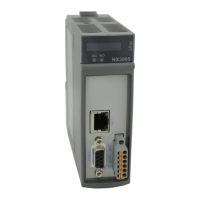5. CONFIGURATION
According to the OPC UA standard, it is possible to define these parameters for each variable. However, many clients
allow you to define common values for all variables configured in a subscription.
The Filter Type parameter must be of DataChangeFilter, indicating that value changes in the variables should cause it to
be transmitted in a Publish Response package.
Deadband Type should be kept in “none” because there is no implementation of deadbands for analog variables. In this
way, any change of the analog variable, however minimal, causes its transmission in a Publish Response package.
To reduce processing power and Ethernet communication bandwidth, you can deploy deadbands on your own as follows:
Do not include the analog variable in a subscription;
Instead, include in a subscription an auxiliary variable linked to the analog variable;
Copy the analog variable to the auxiliary variable only when the user-managed deadband is extrapolated.
5.5.11.6.6. PublishingEnabled, MaxNotificationsPerPublish e Priority
It is suggested that the following parameters be maintained with the following values, which are usually the default values
in the clients:
PublishingEnabled: true
MaxNotificationsPerPublish: 0
Priority: 0
These parameters must be configured for each subscription.
PublishingEnable must be “true” so that the subscription variables are reported in case of change of value.
MaxNotificationsPerPublish indicates how many of the variables that have changed value can be included in the same
Publish Response package. The special value “0” indicates that there is no limit to this, and it is recommended to use this
value so that all changed variables are reported in the same Publish Response package.
Priority indicates the relative priority of this subscription over others. If at any given moment the server should send
multiple Publish Response packages of different subscriptions, it will prioritize the one with the highest value of priority. If all
subscriptions have the same priority, Publish Response packets will be transmitted in a fixed sequence.
5.5.11.7. Accessing Data Through an OPC UA Client
After configuration of the OPC UA Server the data available in all PLCs can be accessed via a Client OPC UA. In the
configuration of the OPC UA Client, the address of the correct OPC UA Server must be selected. In this case the address
opc.tcp://ip-address-of-device:4840. The figure below shows the server selection in the SCADA BluePlant client software
driver.
ATTENTION
Like MasterTool IEC XE, some tools need to be run with administrator rights on the Op-
erating System for the correct operation of the OPC UA Client. Depending on the version
of the Operating System this right must be authorized when running the program. For this
operation right click on the tool executable and choose the option Run as administrator.
170

